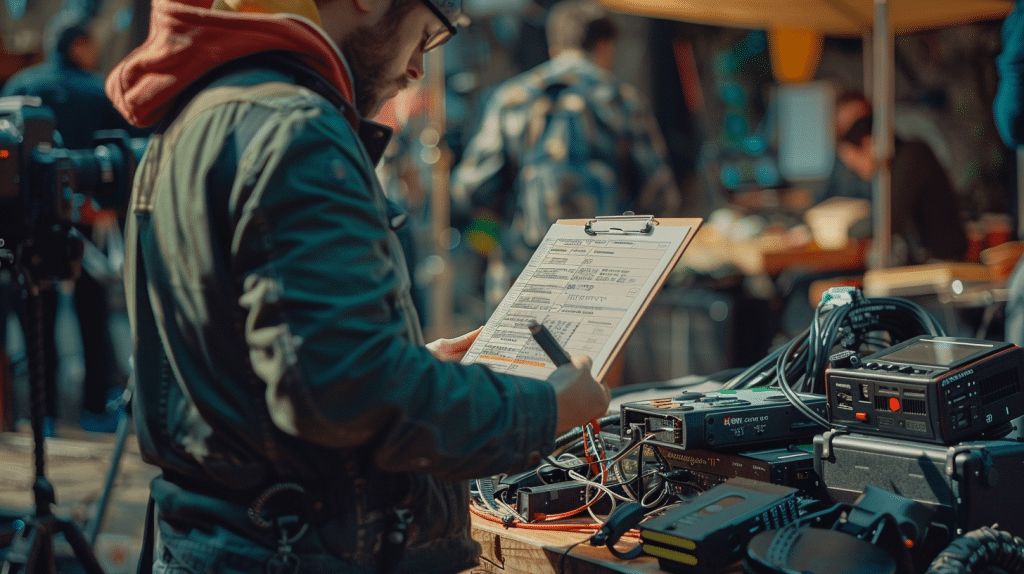How to Stay Organized During a Video Production Shoot

A successful video production shoot requires careful planning and organization. Without the right structure in place, unexpected delays, missed shots, and last-minute problems can derail the project.
Whether you’re managing a corporate video, commercial, or event shoot, following an organized process ensures efficiency, cost-effectiveness, and a stress-free filming day.
This guide covers key steps to streamline your production, from pre-shoot logistics to on-set execution.
📢 Want expert production planning? Get a Free Consultation
Table of Contents
1. Pre-Production Planning: The Key to a Smooth Shoot
Preparation is the foundation of an organized video shoot. The more details you finalize before production day, the easier things will run on set.
Create a Detailed Production Schedule
- Break down filming by time slots (e.g., setup, shooting, breaks, wrap-up).
- Include contingency time for unexpected delays.
- Communicate the schedule to all team members before the shoot.
Finalize the Script & Shot List
- Scripts should be locked in advance to prevent unnecessary rewrites on set.
- A shot list ensures every scene is captured and helps the crew stay on track.
🎯 Pro Tip: Print multiple copies of the schedule and shot list for easy access.
2. Coordinate Locations & Permits in Advance
If your shoot involves multiple locations, securing all necessary permits and permissions is critical.
Confirm Your Filming Locations
- Scout each location ahead of time for lighting, space, and noise considerations.
- Have a backup location ready in case of unexpected weather or issues.
Secure Filming Permits & Permissions
- Check city regulations for commercial shoots in public spaces.
- Obtain property releases if shooting on private property.
🎯 Pro Tip: For Boston shoots, visit the Massachusetts Film Office for permit guidelines.
3. Organize Equipment & Crew Assignments
Prepare a Gear Checklist
A missing piece of equipment can stall production. Keep a checklist of:
- Cameras & lenses
- Lighting & reflectors
- Microphones & audio gear
- Extra batteries, chargers, and memory cards
Assign Clear Roles & Responsibilities
- Director: Oversees the shoot and ensures the vision is executed.
- Camera Operator: Manages framing, focus, and movement.
- Sound Engineer: Handles audio recording and monitoring.
- Production Assistant: Supports logistics and crew coordination.
🎯 Pro Tip: Label all gear cases and bags to prevent mix-ups during load-in and wrap-up.
4. Keep Talent & Crew on Track
Send Call Sheets in Advance
A call sheet provides key details for cast and crew, including:
- Shoot location & time
- Crew roles & contact info
- Wardrobe, props, and equipment needs
Manage Time Efficiently on Set
- Start with the most complex shots first to maximize energy and focus.
- Stick to the schedule but allow room for creativity when needed.
- Have a point person for last-minute issues (e.g., talent delays, equipment malfunctions).
🎯 Pro Tip: Keep extra water, snacks, and seating for the crew—fatigue leads to mistakes.
5. Plan for Post-Production Success
Organize Footage Immediately
- Label all files with clear names (e.g., “ClientName_Scene01_Take02”).
- Back up raw footage on at least two drives.
Track Editing & Review Timelines
- Set clear deadlines for the first cut, revisions, and final delivery.
- Establish a feedback process with designated review points.
🎯 Pro Tip: If multiple stakeholders are involved, use a video review tool (Frame.io, Wipster) to streamline approvals.
Frequently Asked Questions (FAQ)
Q: How do I keep a video production shoot on schedule?
A: Stick to a detailed production schedule, build in buffer time for delays, and have a strong production lead to keep things moving.
Q: What should I do if a problem arises on set?
A: Always have a backup plan for locations, equipment, and talent. Designate a point person for quick problem-solving.
Q: How can I make sure I capture all the necessary shots?
A: Use a detailed shot list and review footage periodically to ensure nothing is missed.
Q: What’s the best way to prepare my team for production day?
A: Share the call sheet and schedule in advance, hold a briefing before the shoot, and ensure everyone understands their roles.
Final Thoughts: Stay Organized & Maximize Efficiency
A well-organized video production shoot saves time, money, and stress. By focusing on pre-production planning, clear communication, and on-set coordination, you’ll ensure a smooth, successful shoot.
📢 Want expert production planning? Let’s Talk.
Share:
Search our blog:
Follow us on:
